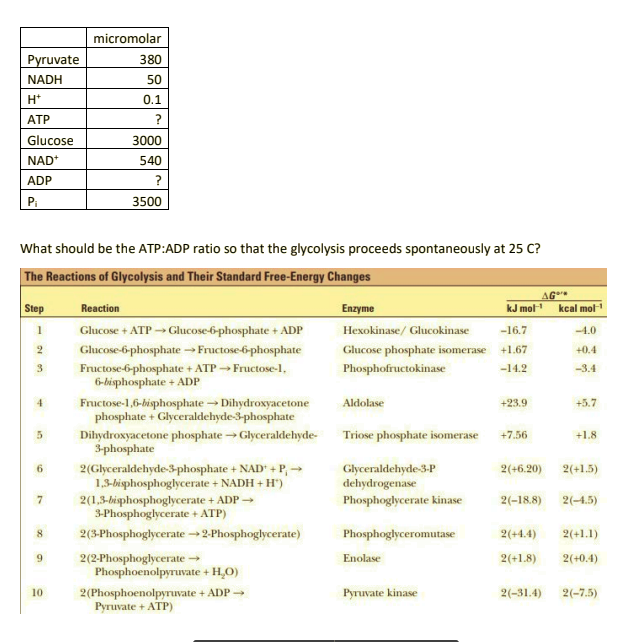Question 8: The following table shows the glycolysis reactions and their standard Gibbs free energy changes at 25 C. Answer the following questions: A. What is the Gibbs free energy expression of the glycolysis pathway? B. What is the overall reaction of the glycolysis pathway? C. Suppose that the physiological concentrations of some metabolites are known as follows:
Question 8: The following table shows the glycolysis reactions and their standard Gibbs free energy changes at 25 C. Answer the following questions: A. What is the Gibbs free energy expression of the glycolysis pathway? B. What is the overall reaction of the glycolysis pathway? C. Suppose that the physiological concentrations of some metabolites are known as follows:
Biology 2e
2nd Edition
ISBN:9781947172517
Author:Matthew Douglas, Jung Choi, Mary Ann Clark
Publisher:Matthew Douglas, Jung Choi, Mary Ann Clark
Chapter7: Cellular Respiration
Section: Chapter Questions
Problem 19CTQ: Nearly all organisms on Earth carry out some form of glycolysis. How does this fact support or not...
Related questions
Question
Please show steps and part a we should have an expression of the glycolysis pahthway.

Transcribed Image Text:Question 8: The following table shows the glycolysis reactions and their standard Gibbs free energy
changes at 25 C. Answer the following questions:
A. What is the Gibbs free energy expression of the glycolysis pathway?
B. What is the overall reaction of the glycolysis pathway?
C. Suppose that the physiological concentrations of some metabolites are known as follows:

Transcribed Image Text:micromolar
Pyruvate
380
NADH
50
H*
0.1
ATP
?
Glucose
3000
NAD+
540
ADP
?
Pi
3500
What should be the ATP:ADP ratio so that the glycolysis proceeds spontaneously at 25 C?
The Reactions of Glycolysis and Their Standard Free-Energy Changes
Step
Enzyme
AG
kJ mol kcal mol
Reaction
Glucose + ATP → Glucose-6-phosphate + ADP
Hexokinase/ Glucokinase
-16.7
-4.0
Glucose-6-phosphate →Fructose-6-phosphate
Fructose-6-phosphate + ATP → Fructose-l,
6-bisphosphate + ADP
Fructose-1,6-bisphosphate Dihydroxyacetone
phosphate + Glyceraldehyde-3-phosphate
2
Glucose phosphate isomerase +1.67
+0.4
3
Phosphofructokinase
-14.2
-3.4
Aldolase
+23.9
+5.7
Dihydroxyacetone phosphate→ Glyceraldehyde-
3-phosphate
Triose phosphate isomerase
+7.56
+1.8
2(Glyceraldehyde-3-phosphate + NAD* + P, →
1,3-bisphosphoglycerate + NADH + H")
Glyceraldehyde-3-P
dehydrogenase
2(+6.20)
2(+1.5)
7
Phosphoglycerate kinase
2(1,3-bisphosphoglycerate + ADP →
3-Phosphoglycerate + ATP)
2(-18.8)
2(-4.5)
2(3-Phosphoglycerate →2-Phosphoglycerate)
Phosphoglyceromutase
2(+4.4)
2(+1.1)
9.
2(2-Phosphoglycerate -
Phosphoenolpyruvate + H,O)
Enolase
2(+1.8)
2(+0.4)
2(Phosphoenolpyruvate + ADP →
Pyruvate + ATP)
10
Pyruvate kinase
2(-31.4)
2(-7.5)
Expert Solution
This question has been solved!
Explore an expertly crafted, step-by-step solution for a thorough understanding of key concepts.
Step by step
Solved in 2 steps

Knowledge Booster
Learn more about
Need a deep-dive on the concept behind this application? Look no further. Learn more about this topic, biology and related others by exploring similar questions and additional content below.Recommended textbooks for you

Biology 2e
Biology
ISBN:
9781947172517
Author:
Matthew Douglas, Jung Choi, Mary Ann Clark
Publisher:
OpenStax

Biology 2e
Biology
ISBN:
9781947172517
Author:
Matthew Douglas, Jung Choi, Mary Ann Clark
Publisher:
OpenStax